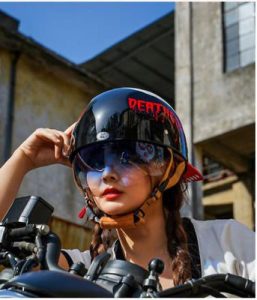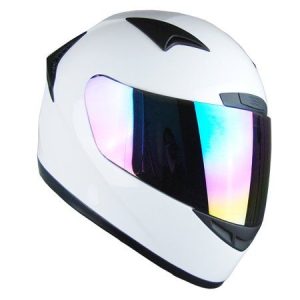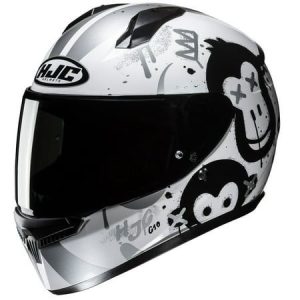Jun 24, 2024
Are Novelty Motorcycle Helmets Safe?
For motorcycle riders, safety is paramount. A crucial piece of safety equipment is a helmet. However, with the rise of novelty motorcycle helmets, the question of safety arises. Are novelty motorcycle helmets safe? This article explores the key characteristics of novelty motorcycle helmets and why they may not provide the same level of protection as Department of Transportation (DOT) approved helmets. Find your motorcycle helmet.
The Allure of Novelty Helmets
Novelty motorcycle helmets come in various designs, shapes, and sizes. They may feature unique graphics, unusual materials, or non-traditional forms. While they may appeal to riders seeking a distinctive look, prioritizing safety should always come first.
Why DOT Approval Matters
DOT is a federal agency in the United States that sets safety standards for various products, including motorcycle helmets. DOT-approved helmets undergo rigorous testing to ensure they meet specific criteria for impact resistance, penetration resistance, and retention system strength.
Here’s a breakdown of what DOT approval entails:
Impact Resistance:
Helmets are subjected to impacts simulating real-world crashes to ensure they absorb and distribute the force of a blow.
Penetration Resistance:
Helmets are tested to ensure they can withstand sharp objects without puncturing the shell and injuring the rider’s head.
Retention System Strength:
The chin strap and retention system are tested to ensure the helmet stays securely fastened on the rider’s head during a crash.
 The Risks of Novelty Helmets
The Risks of Novelty Helmets
Since novelty motorcycle helmets are not required to comply with DOT standards, they may not offer the same level of protection in a crash. Here’s a closer look at the potential risks:
- Flimsy Shells: Some novelty helmets may be made from weaker materials that could shatter on impact, leaving the rider’s head vulnerable.
- Inadequate Padding: Proper padding is crucial for absorbing impact energy. Novelty helmets may lack sufficient padding or use low-quality materials that don’t offer optimal protection.
- Weak Chin Straps: A secure chin strap is vital to ensure the helmet stays on during a crash. Novelty helmets may have weak or ill-fitting chin straps that could fail.
Protecting Yourself on the Road
Choosing a DOT-approved helmet is an essential step to staying safe on the road. Here are some additional tips for motorcycle helmet safety:
- Proper Fit: A helmet should fit snugly and securely. It shouldn’t move excessively when you shake your head.
- Visor Safety: Ensure your helmet’s visor is DOT-approved and offers scratch and impact resistance.
- Replace When Needed: Helmets can wear down over time and lose effectiveness. Replace your helmet after a crash or every five to seven years.
While novelty motorcycle helmets may offer a unique aesthetic, their lack of DOT approval raises safety concerns. When it comes to protecting yourself on the road, prioritize safety over style. Choose a DOT-approved helmet that fits you properly and offers the best chance of keeping you safe in the event of a crash.

Selecting a Safe and Comfortable Helmet
DOT approval is a crucial starting point, but there are other factors to consider when choosing a motorcycle helmet:
-
Helmet Type: There are various styles of DOT-approved helmets, each with its own advantages. Here are some popular choices:
- Full-face helmets offer the most comprehensive protection for your head, face, and neck.
- ¾ helmets, also known as open-face helmets, provide protection for your head but leave your face exposed.
- Half helmets offer minimal protection and are not recommended for all riders.
-
Fit is Key: A properly fitting helmet is essential for optimal safety and comfort. The helmet should feel snug but not too tight. You should be able to move your head slightly, but the helmet shouldn’t rock or wobble excessively.
-
Visor Considerations: A clear, DOT-approved visor is vital for good visibility. Look for a visor that is scratch-resistant and offers UV protection. Some visors come with anti-fogging features for added comfort.

Additional Safety Tips for Motorcycle Riders
Equipping yourself with a DOT-approved helmet is an important step towards motorcycle safety. Here are some additional tips to keep in mind:
- Take a Motorcycle Safety Course: Enrolling in a motorcycle safety course can equip you with the knowledge and skills to navigate the road safely.
- Wear Protective Gear: Leather or other abrasion-resistant clothing, gloves, and sturdy boots offer additional protection in the event of a crash.
- Ride Within Your Limits: Avoid excessive speed, be mindful of weather conditions, and avoid riding under the influence of alcohol or drugs.

Ride Smart
- Motorcycle Safety Course: Enrolling in a motorcycle safety course equips you with the knowledge and skills to handle your motorcycle safely and navigate various road conditions.
- Defensive Riding: Practice defensive riding techniques, anticipating potential hazards and maneuvering accordingly.
- Road Awareness: Stay alert to your surroundings, watch out for other vehicles, and avoid distractions while riding.
- Weather Conditions: Be mindful of weather conditions. Avoid riding in heavy rain, strong winds, or icy conditions.
The Importance of Maintenance
- Regular Inspections: Perform regular inspections of your motorcycle to ensure everything is in proper working order, including brakes, tires, and lights.
- Tire Care: Maintain proper tire pressure and check the tread depth regularly. Replace worn-out tires to ensure optimal grip on the road.
- Brakes: Ensure your brakes are functioning properly and have them serviced regularly.

Gear Up for the Ride
- Protective Clothing: Abrasion-resistant clothing minimizes injuries if you slide across pavement in a crash. Look for jackets, pants, and gloves made of leather or other tough materials.
- Footwear: Sturdy boots offer protection for your feet and ankles. Avoid sandals or sneakers that could easily tear off in a crash.
Visibility Matters
- Reflective Gear: Equipping yourself and your motorcycle with reflective gear makes you more visible to other motorists, especially at night or in low-light conditions.
- Headlight Usage: Keep your headlight on during the day as well as at night to increase your visibility.
Conclusion: Ride On, Ride Safe
Motorcycling can be a thrilling and liberating experience. By prioritizing safety and choosing a DOT-approved helmet that fits you properly, you can minimize risks and maximize your enjoyment on the open road. So, gear up responsibly, and embrace the ride!